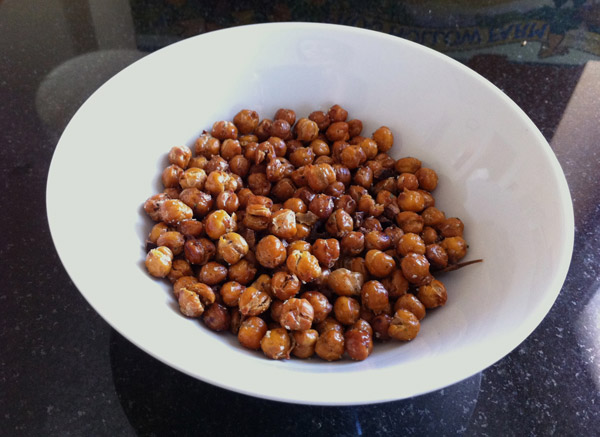How to Thrive in a Toxic Food Environment that Encourages Bad Choices
By Adam Brown
 by Adam Brown
by Adam Brown
twitter summary: How to thrive in a food environment that encourages bad choices – ten tactics that I use!
short summary: It can be really hard to make healthy choices when our food environment encourages the opposite. My top ten ways to survive: avoid processed foods/sugar; choose natural foods when possible; cook at home; don’t bring tempting food home with me; be smart when eating out; eat fruit when craving something sweet; choose nuts and salads when I’m on-the-go; ask, “Am I really hungry?”; know my weaknesses; and follow this simple rule by the master, Michael Pollan: “Eat food. Not too much. Mostly plants.”
We live in a food environment that is truly toxic for diabetes and obesity. It relentlessly encourages bad choices in just about every domain. It ingrains bad habits from an early age and reinforces those habits through the ~6,000 food ads children 2-17 years old see each year. Even at diabetes and obesity conferences – where the frontline medical professionals are learning cutting-edge science – junk food is abundantly served (see my chronicle on twitter at #ConferenceFoodFail). Though I’ve always recognized this fact, I recently saw food writer Michael Pollan speak here in San Francisco, read one of his terrific books (In Defense of Food: An Eater’s Manifesto), and watched the compelling new documentary Fed Up (now playing in select theaters nationwide). All pointed to the same conclusion – each of us is fighting a major uphill battle to make healthier eating choices every single day.
With this in mind, I thought I would share my own personal strategies for navigating our modern day food system. I recognize that many of these rules are quite strong, fervent, and they are absolutely not for everyone. This is just what works for me, but I thought sharing it might be useful for some diaTribe readers. Here goes!
-
Avoid processed foods and sugar whenever possible – that includes soda, fruit juice,
 desserts, candy bars, chips, crackers, etc. (what Michael Pollan humorously terms, “Food-like substances”). I find a black-and-white rule like this is much easier than, “I’ll buy chips and candy but hide it in the pantry, and only eat it at certain times in moderation.” No! Your brain is hardwired to love and crave sugary processed foods. Some research suggests sugar is eight times more addictive than cocaine. I find it’s easier to just stay away from it altogether. Of course, I do recognize that having these items on hand for hypoglycemia makes sense, but resisting the temptation to eat/overeat them is often incredibly hard (see #3). That’s why I use glucose tabs when I’m low – they may not taste great, but I certainly won’t eat a pile of them either.
desserts, candy bars, chips, crackers, etc. (what Michael Pollan humorously terms, “Food-like substances”). I find a black-and-white rule like this is much easier than, “I’ll buy chips and candy but hide it in the pantry, and only eat it at certain times in moderation.” No! Your brain is hardwired to love and crave sugary processed foods. Some research suggests sugar is eight times more addictive than cocaine. I find it’s easier to just stay away from it altogether. Of course, I do recognize that having these items on hand for hypoglycemia makes sense, but resisting the temptation to eat/overeat them is often incredibly hard (see #3). That’s why I use glucose tabs when I’m low – they may not taste great, but I certainly won’t eat a pile of them either. -
Choose natural, whole foods as much as possible. Fewer ingredients is always the way to go. Even things as simple as bread these days have 40+ ingredients – like Michael Pollan urges, I try to stick to food items that look, sound, and feel like “real food.” Single ingredient items are my goal at every meal – fruits, vegetables, lean proteins, nuts, and seeds.
-
Cook at home whenever possible. One of my favorite things to do at restaurants is to look at nutrition information – it’s truly astonishing how many unhealthy added calories are embedded in what seem like “healthy” foods (e.g., Cheesecake Factory’s Chicken Caesar Dinner Salad is a mind-blowing 1,510 calories!). Rather than try to navigate these dark and murky waters, I find it’s just easier to sail home and cook in my own kitchen – I can control exactly what’s in my food and count the carbs accurately. Plus, I find it’s a lot of fun.
-
When shopping, don’t bring temptation home. A great way to eat better is simply not to buy junk food in the first place – if it’s not in the pantry, you automatically prevent yourself from eating something damaging. When you’re hungry at 11 pm and all you have are whole foods in the kitchen, you’re much more likely to make a good choice.
-
When you do eat out, prepare for war! You must be strategic to avoid a menu of landmines. Here are a few tactics I use:
-
Substitute vegetables for high-carb restaurant side dishes. Even nutritionists cannot correctly guess the carbs in that pile of rice or potatoes. I certainly can’t either, so I just steer clear of it.
-
Don’t eat the bread. In fact, I often don’t even let them bring it to the table.
-
If you order a salad, get the dressing on the side. Those calories are empty and add up FAST. Balsamic vinegar and/or olive oil are my default options.
-
Avoid white foods, especially potatoes, French fries, rice, and white bread.
-
-
When desiring something sweet, eat fruit. I opt for lower glycemic
index fruit whenever possible – berries are my go-to (strawberries, raspberries, blueberries), since they raise glucose slowly, are super filling and tasty, and can be purchased frozen. I always steer clear of dried fruit – it’s a sugar bomb and spikes my blood glucose very quickly.
-
When traveling and in need of a snack, nuts or a salad are a safe and healthy go-to. You can generally always find these in airports, convenience stores, or gas stations. I’m always guilty of overeating the calorie-heavy nuts, so I try to buy unsalted options and smaller packs. As noted above with salads, I get the dressing on the side and avoid anything crouton-like.
-
Always ask myself, “Am I really hungry?” Often, I find my brain is craving food, but I am not truly “hungry” in the stomach-grumbling sense. Being more mindful of how I feel is an ongoing learning process, and a huge asset when I get it right. Certainly, it prevents me from overeating right after a meal and in between meals.
-
Know my weaknesses. What food can I not stop eating once it’s in front of me? Goldfish crackers. The best way I’ve learned to combat this is to never buy them or eat them. Period. I know that’s what some might consider extreme, but I absolutely prefer to give up Goldfish crackers than to deal with the nightmare blood sugar consequences of eating multiple cups of them.
-
When in doubt, follow Michael Pollan’s seven-word maxim: “Eat food. Not too much. Mostly plants.” These seven words are what he calls “the short answer to the supposedly incredibly complicated and confusing question of what we humans should eat in order to be maximally healthy.” We all can remember seven words!
What strategies do you use to stay healthy in our modern food environment? Email me with any that I missed!
[Editor’s Note: Adam is a patient with diabetes and not a healthcare provider. Please consult with your healthcare provider before making any changes to your diet, insulin, or medication regimen.]
Adam is the co-managing editor of diaTribe and Chief of Staff/Head, Diabetes Technology at Close Concerns. He is a graduate of the University of Pennsylvania and serves on the board of Insulindependence and the San Francisco branch of JDRF. He was diagnosed with type 1 diabetes at the age of 12 and has worn an insulin pump for the last 11 years and a CGM for the past four years. Much of Adam's writing for Close Concerns and diaTribe focuses on diabetes technology, including blood glucose meters, CGMs, insulin pumps, and the artificial pancreas. Adam is passionate about exercise, nutrition, and wellness and spends his free time outdoors and staying active. He can be contacted at adam.brown(at)diatribe.org or @asbrown1 on twitter.
Never miss an update by signing up here to receive free updates on future diaTribe articles.







